The Beast of Zhevodan: a fairy tale with an unhappy ending
The summer of 1764 was very hot. By noon on June 1, the sun was scorching mercilessly and a shepherdess from the town of Langon decided to drive a herd of cows closer to the trees to hide from the scorching rays in the shade of century-old oaks. The cry of a woman alarmed a small settlement and everyone who heard it hurried to the Mercoire forest.
At the very edge of the meadow, where the juicy grass turns into a shrub, a frightened shepherdess was sitting on the ground and screamed shrilly, holding her bloody neck with her hand. This is how the terrible story began, which claimed the lives of 119 people from the villages of the province of Zhevodan in 4 years.

The first attack of an unknown creature from the forest on a person did not lead to a tragedy — at that moment, when something from the thicket clung to the woman's neck from behind, several bulls were grazing nearby, which, trying to protect the herd, rushed at the enemy and frightened him. The victim escaped with scars on her neck and fear that haunted her for the rest of her life.

The next people who encountered the Zhevodan monster were much less lucky. The first victim of the beast was Jeanne Boulet, 14 years old, who was found dead on June 30, 1764 near the small village of Hubacs.
Less than a month later, something killed two more children — a girl and a boy. Upon examination of these two bodies, it became obvious that the wounds were inflicted by a large animal, which is larger than a wolf, but much smaller than a bear. The conclusions of experienced hunters made at the scene led to the fact that within a few days the entire county of Zhevodan was sure that a werewolf was hunting for people.
But the unknown creature was not interested in what the peasants were saying about it — it was extremely voracious and preferred to hunt people rather than livestock. By the beginning of autumn, the beast had gathered a bloody harvest of 5 children, aged from 7 to 15 years. In some cases, something ate most of its prey, and sometimes it just killed, as if for fun.
When the total number of dead and missing reached 11 in October, it was decided to organize a large roundup with the participation of the military and dozens of hunters from Langoni, Yubak and several surrounding villages. The Count de Montcamp, the governor of Languedoc, sent 56 dragoons to the Mercoir Forest, led by his best officer, Jacques Duhamel.
Hunters with dogs and dragoons combed the forest up and down, shooting and raising more than a hundred wolves on slingshots, but there was no animal among them that could separate a person's head from his body with two or three bites. The dragoons retreated to their barracks, and the villages were again plunged into chilling horror.
Much luckier than Duhamel and his brave soldiers were two local hunters who, in the last days of October 1764, went to the forest for game. At the edge of the forest, the men came face to face with a huge black wolf, which without hesitation rushed to attack.
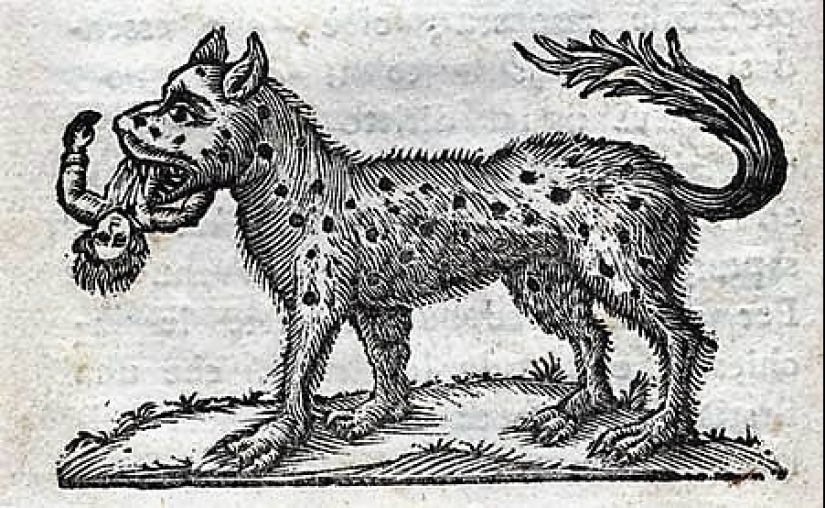
The hunters were lucky that their guns were loaded, and the powder turned out to be dry — the first shot fired at the attacking wolf from less than 10 meters hit the target and turned it into flight. The second shot, made in pursuit, was also successful and the brave hunters rushed to chase the prey along the abundant bloody tracks. They failed to catch up with the animal, but not far from the meeting place with the wolf, in the bushes, they found the torn and partially eaten corpse of a 21-year-old boy, whom the beast killed shortly before the meeting with the hunters.
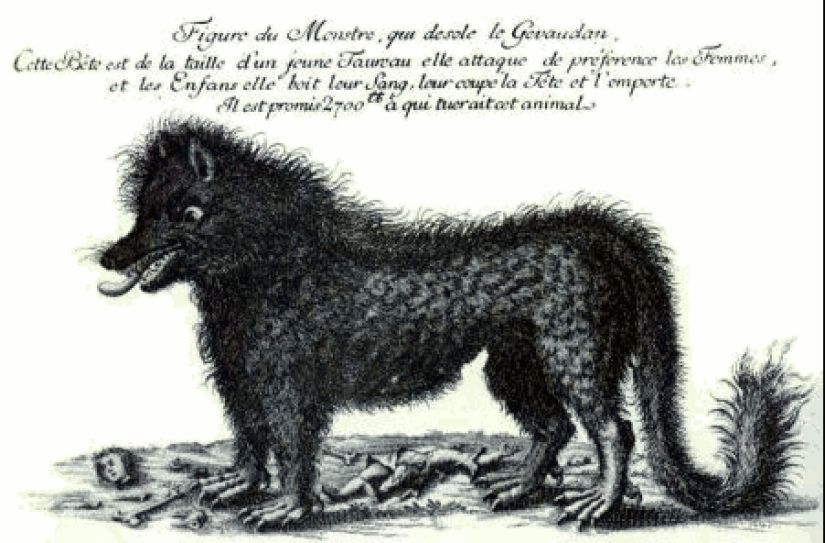
After these events, the beast from Zhivodan was not heard of for almost a month, and the peasants had hope that the monster died of wounds. However, on November 25, the death from the forest claimed the life of Catherine Valli (Catherine Vally), 70 years old, who went to the mountains for firewood. Throughout December, attacks occurred almost daily, and on December 27, the wolf went on a record-4 attacks with 2 killed. The sad result of 1764 is 27 people killed and brutally maimed by a monster.
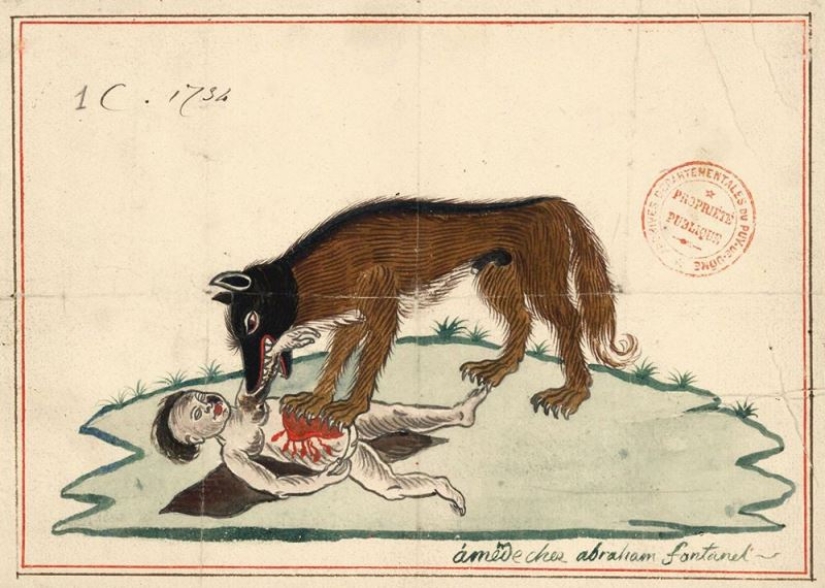
At the beginning of 1765, an event occurred that somewhat dispelled the mystical halo over the man-eating beast and gave the inhabitants of the surrounding villages a faint hope of salvation. On January 12, a group of seven children, aged from 9 to 13 years, encountered a huge black wolf on the edge of the forest.
Seeing that it was useless to run, the brave kids began to shout and throw stones and branches at the animal. The attack was led by 13-year-old Jacques Portfeu, who set an example of courage to everyone else. For the first time, the cruel killer, who was rebuffed for the first time, was confused and, with his tail between his legs, ran away. However, this event did not interfere with the planned meal — on the same day, but later, the wolf still killed the child in almost the same place. The victim was a young de Grez, the son of a local resident, who went to the forest in search of his friends. In total, January claimed 18 lives.
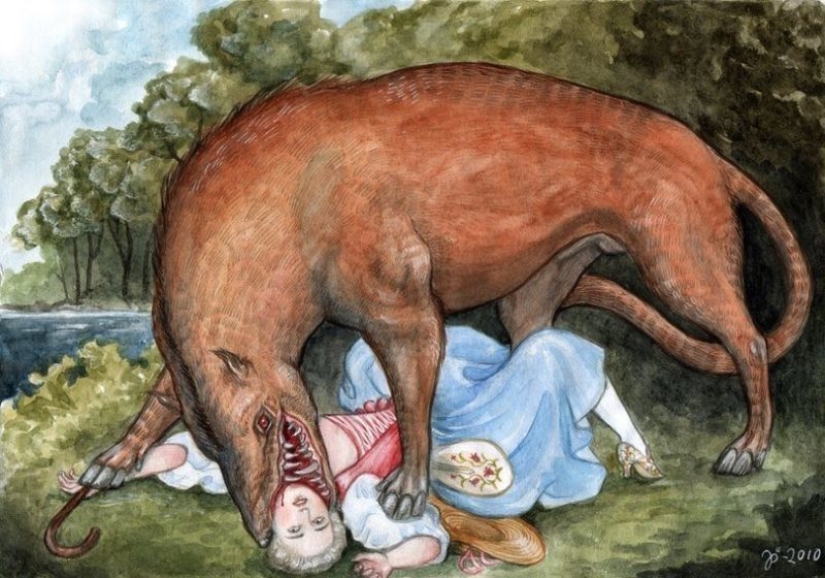
February passed restlessly — the beast attacked with the same regularity, with the only difference that now it began to make mistakes more often and leave its victims alive. Perhaps the injuries inflicted by the hunters affected, but the animal more often did not finish the job or retreated when he saw that they were ready to fight back.
In the spring of 1765, the attacks became so frequent that they occurred almost every other day. On April 5, the monster attacked four children who could not fight back as a group of Portfes and all of them died. In the summer, the monster somewhat moderated its appetites, but as of September 12, 1765, it still had 134 attacks and 55 victims on its account.

The matter took such a serious turn that the monarch himself took control of it. Louis XV wished to see the young Jacques Portfeu, who was not afraid of the monster from Zhivodan, and awarded the boy and his friends 300 livres. Immediately after that, the king, angered by the helplessness of the local authorities, ordered to invite the best hunters of France to the court to personally give them the task of destroying the beast.
Professional hunters arrived in Versailles from Normandy-Jean-Charles-Marc-Antoine Vomesl d’Enneval and his son Jean-Francois d’Enneval. The track record of these hunters was as long as the names-on the account of d’Enneval Sr. had at least 1,000 predators caught and killed. Ludovic was informed that if these two do not cope, then no one else will help.
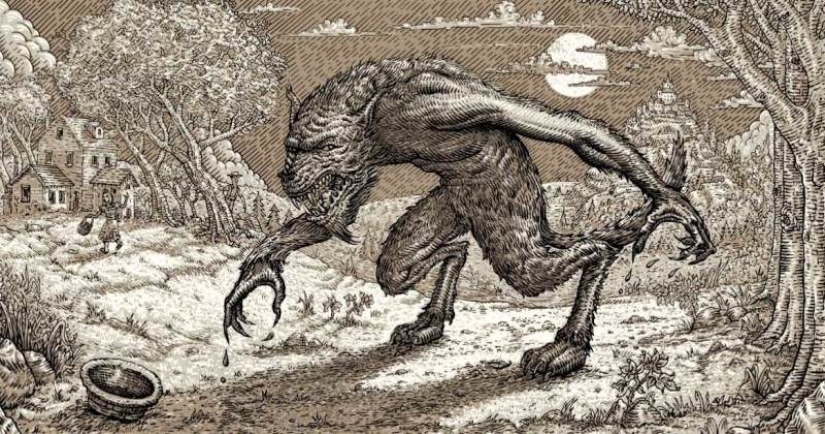
On February 17, 1765, the operation to destroy the beast from Zhivodan began. The father and son set up their headquarters in the town of Clermont-Ferrand, the closest to the place of the raid. The professionals brought with them a pack of hounds trained for wolves and several servants. Also, in the name of the king, soldiers of local guard and dragoon regiments, nobles and commoners were involved in large-scale hunting.
The hunt dragged on for several months, not stopping even during bad weather. The raids followed one after another, and the number of participants, thanks to the royal gold, was constantly growing. The most massive departure to the forests took place on August 9, 1765 — more than 600 volunteers and 117 soldiers and officers of the royal army took part in the departure.
But even the largest hunt in the history of France, if not the whole of Europe, did not bring results — the man-eating wolf was elusive. As if in mockery of the hunters, the beast made another attack on August 11, two days after the raid.
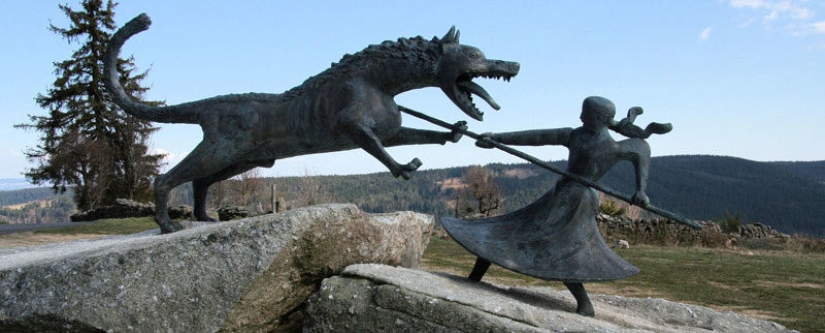
The operation ended in nothing — hundreds of wolves were killed, hectares of peasant crops were trampled and hundreds of liters of wine were drunk, but the monster continued its attacks. Shamed father and son d’Enneval, having apologized to the king, retired to their native Normandy, and the place of a specialist in man-eating wolves was again vacant.
Soon, the court hunter of Louis XV, Francois-Antoine de Botern, who had the high-profile title of the Bearer of the Royal Arquebus, arrived in the place of the Normans. Despite the ridiculous rank and knowledge of court etiquette, the new St. John's wort turned out to be more effective than its predecessors. During three months of active raids, de Botern with his assistants and local hunters killed more than 1,200 wolves!
In the autumn of 1765, a raid consisting of a royal pet, 40 professional hunters and 12 dogs, encountered a large wolf in the forest thicket, which was mistaken for a Zhivodansky beast. De Botern received the right of the first shot, but his bullet only tangentially wounded the animal in the shoulder.
One of the hunters shot at the animal trying to escape, and his shot was successful — the bullet hit the wolf in the eye and passed through the skull, coming out of the back of the head. The animal fell dead, and the participants of the raid already decided that he was dead. But as soon as de Botern approached the monster, it jumped up again and tried to bite it with its teeth. Another shot, made at point-blank range by someone from the group of hunters, finished off the predator, and he finally gave up the ghost.
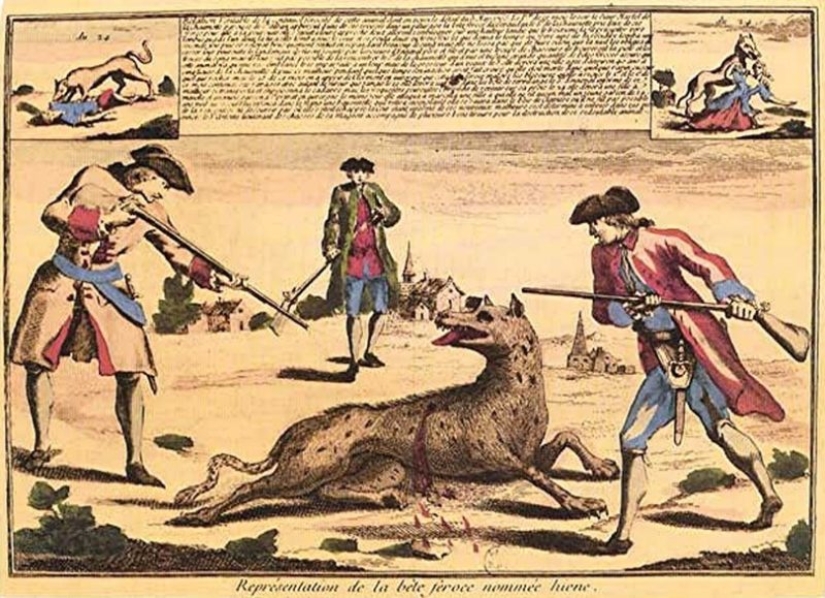
The prey turned out to be very large — the wolf reached 170 cm in length, and its height at the withers was 80 cm. The monster weighed 60 kg. Since the events unfolded near the Abbey of Shaz. The wolf was immediately dubbed the "Beast of Shaz". De Botern hastened to report to the crowned patron about the success, adding that the animal had unprecedented size and incredible vitality. It was a little confusing that everyone described the Zhevodansky werewolf as a coal-black wolf, and the killed animal was of an ordinary, gray color.
Based on the appearance of the predator and a piece of red cloth found in its stomach, it was decided that the Zhevodan beast was finally finished. An effigy was made from the killed wolf, which the Bearer of the Arquebus delivered to the king personally. All participants of the hunt were rewarded for their efforts and courage, and De Botern was honored at Versailles as a hero.

The last week of autumn passed quietly in the vicinity of Zhivodan, which many perceived as confirmation of the end of the terrible story with the wolf. But on December 2, trouble again came to the vicinity of the Mercoir forest-near the village of Besser-Saint-Marie, a large predator attacked two children, 7 and 14 years old,who were seriously injured, but survived.
On December 10, two women returning from visiting Lashan were injured, and on December 14, a 21-year-old boy barely managed to escape from a huge black wolf that chased him all the way to the village. On December 21 and 23, new victims appeared again and fear returned to people's homes.
In 1766, people died constantly, but not too often — the monster was limited to 2-3 attacks. In total, since the killing of the wolf from Shaz, 41 predator attacks have been recorded in the villages of the province of Zhevodan. On November 1, 1766, having finally torn apart 12-year-old Jean-Pierre Ollier near the village of Sucher, the beast disappeared.
For 122 days there was not a single attack, and everyone believed that the series of deaths had finally stopped. But on March 2, 1767, the monster went hunting again, killing and eating a little boy near the village of Pontaju. After a rest, the Zhevodansky wolf began his bloody work with renewed vigor — 8 attacks in April and 19 in May again plunged the peasants into despair.
This situation again required the intervention of those in power and the Count d'apche, a local influential aristocrat, took up the matter. The best hunters of the province and visiting masters of rifle shooting once again gathered under the banner of the nobleman. On June 19, 1767, during a raid in which more than 300 people participated, the man-eating wolf was finally destroyed.

History has preserved the name of the person who made a well-aimed shot at the predator — his name was Jean Chastel (Jean Chastel). This hunter had no high-profile titles and brilliant victories, differing from his colleagues only in his pathological piety. On the hunt, Jean took silver bullets and a Bible, which he read at every camp.
During one of the evening prayers, Shastel was lucky. A huge wolf rushed out of the bushes at him, holding a gun in one hand and an Old Testament in the other. The man attributed his salvation to the Bible for the rest of his life, because otherwise it was difficult to explain why the wolf suddenly stopped in front of him and froze.
Shastel shot the wolf in the chest with a silver bullet, and he fell. Offering prayers, Jean quickly reloaded the gun and unhindered smashed the monster's head with a second shot. The hunter who killed the satanic spawn with God's help became a hero, but the material reward he received was, for some reason, modest. The reward for the savior was collected among the local peasants, so the prize was only 72 livres.

The examination and autopsy of the killed animal, conducted by local aesculapians under the supervision of the royal notary, disappointed everyone. The slain beast was smaller than the wolf from Shaz and was also not black. The animal's fur was gray with red markings, and on the there were several black stripes on the sides and at the base of the tail.
In the stomach of the beast, among unidentified pieces of flesh, the forearm of a girl who disappeared nearby was also found. Therefore, it was quite obvious that the killed predator was a cannibal.

The corpse of the monster was also presented to the victims who were lucky to survive when meeting with the beast — most of them confidently identified the animal. The whole body of the beast was covered with scars, and in the right hip joint the royal notary found three pellets, once planted in the creature from a gun by a local horse dealer.
Many believe that the lucky shot of Jean Chastel is just part of a grand criminal deception. The fact is that the son of a devoutly believing hunter, Antoine Chastel, was an extravagant and unmanageable person.
The young man lived alone in a large house on Mont Mouchet Mountain, was engaged in breeding hunting dogs and had a very interesting biography. In his youth, having run away from home, Antoine Chastel traveled a lot around the world. The adventurer was especially attracted to the African continent, which he visited repeatedly.
The man, despite his rather young age, managed to live among the Berbers of the Sahara, to visit as a prisoner on the galleys of Algerian pirates and to make an expedition to the interior of the Black continent. It is quite possible that the bloodthirsty monster was one of the traveler's pets, which he sometimes released on a bloody hunt.

This version is supported by the fact that the respite that the monster gave everyone in the autumn of 1766 coincided with the period that Antoine, his brother and father spent under arrest in the prison of the city of Sozhe.
A suspicious family got behind bars for getting involved in a scuffle with a royal hunter in the forest. Botern and his companions, combing the forest in search of the killer beast. The Shastels were forgiven on December 1, and just a day later the predator's attacks continued. These events coincidentally coincided with a successful hunt for a wolf from Shaz, which assured everyone that the Zhevodan beast was dead.

A century after the completion of the story with the Zhevodan beast, scientists tried to find any material artifacts that would allow for an accurate identification of the animal, but there was nothing to cling to except the notary's records.
Keywords: Wolf | Forest | Werewolf | France
Post News ArticleRecent articles

On the eve of the New Year, a magical atmosphere reigns in every house — everything is hung with shiny tinsel, there is an ...

Motherhood significantly changes a woman's body. But there are more profound changes affecting the nature and Outlook. Reflected in ...
Related articles

Everyone knows the story of a little boy Mowgli, who once found himself alone in the middle of the jungle and was brought up in a ...

There is no shortage of advice on how to survive in extreme situations these days. Numerous television shows, movies, specialized ...

The Tsingi du Bemaraha Nature Reserve is located on the west coast of Madagascar and is famous for its amazing stone forest. The ...

Some people have genetic abnormalities that make their appearance unique. These body features are usually inherited from parents, ...